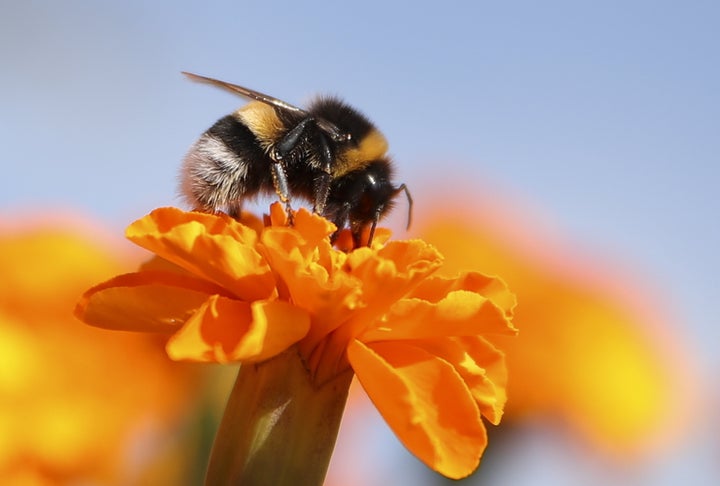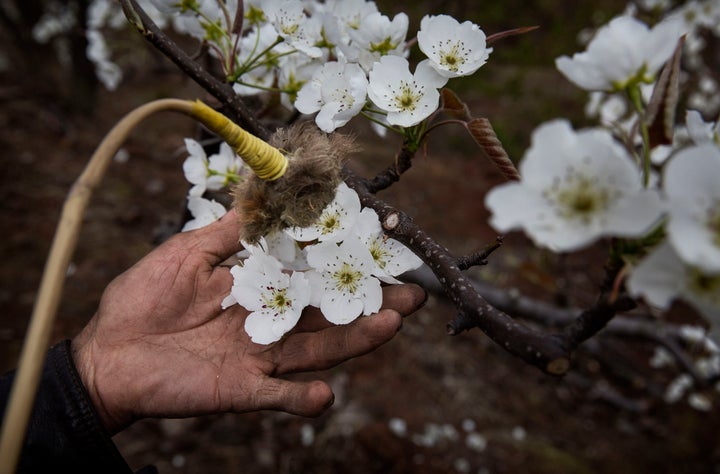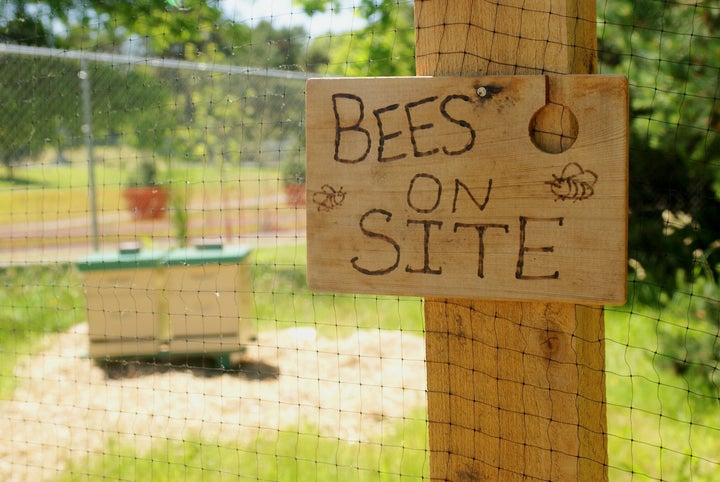Across North America and Europe, bees are suffering dramatic species loss due to the climate crisis
Thanks to our ever-warming planet, bumblebee populations ― which are already threatened by pesticides and habitat loss ― have declined 46% in North America and 17% in Europe compared with baseline numbers from 1901 to 1974, according to a new study published in the journal Science.
“The scale of this decline is really worrying,” Peter Soroye, a doctoral student in biology at the University of Ottawa and lead author of the study, told The New York Times. “This group of organisms is such a critical pollinator in wild landscapes and agricultural regions.”
It’s estimated that between $235 billion and $577 billion worth of annual food production globally relies on the pollinator services of more than 20,000 types of bees, along with birds, bats, and butterflies.
Three years ago, the rusty patched bumblebee was listed as endangered by the U.S. Fish and Wildlife Service after it was found that its population across the country had declined by 90% since the 1990s. A declining bee population undermines the world’s ability to produce food.
In the U.K., a study in May found that 17 species of bees are considered regionally extinct ― including the great yellow bumblebee, the Potter flower bee and the cliff mason bee ― 25 were threatened, and an additional 31 were considered of concern to conservationists. And of Europe’s more than 800 bee species, 171 are considered either endangered, vulnerable or near-threatened.
Bees are just one part of a severe biodiversity crisis, which could see a million species go extinct over the next decade because of human actions. To solve it, we must rapidly decrease emissions, slash pollution and protect land.
“Land degradation, biodiversity loss and climate change are three different faces of the same central challenge: the increasingly dangerous impact of our choices on the health of our natural environment,” Robert Watson, chair of the U.N. study, told HuffPost.
But there are glimmers of hope to be seen in the efforts of individuals, communities, cities and countries to try to stop the demise of bees. From paying residents to grow pollinator lawns to banning pesticides, here are five reasons to have some hope for the future of bees.
Paying people to create bee-friendly gardens

In the U.S., 104 cities have registered as “Bee Cities” ― meaning they are committed to improving pollinator habitat, raising awareness with residents about bees, and incorporating “pollinator-conscious” policies into city planning.
Meanwhile, in an effort aimed specifically at supporting the threatened rusty patched bumblebee, Minnesota approved a new “Lawns to Legumes” program toward the end of 2019. The program will pay out a total $900,000 each year to homeowners (up to $350 each) who replace their manicured grass lawns with pollinator-friendly wildflowers, clover and native grasses.
“I have gotten a ton of emails and so much feedback from people who are interested in this,” state Rep. Kelly Morrison, who introduced legislation implementing the program, told the Star Tribune. “People are really thinking about how they can help.”
And for anyone interested, the Million Pollinator Garden Challenge was launched in 2015 to encourage people across the U.S. to add their bee and butterfly-friendly gardens to the map.
Planting gardens on roofs of buildings and bus stops

One of the best known cities for green roof infrastructure is Chicago. As of 2017, more than 350 had been installed. The policy supporting green roofs was aimed at combating the urban heat-island effect that keeps urban areas hotter than their surroundings. However, these green roofs have added benefits for bee populations.
Initial studies indicate that with the right plants, green roofs can support wild bee species. But this is particularly successful when there are more ground-level gardens and green areas nearby.
Several other cities are also seeing a surge in green roofs, including Newark, New Jersey; Washington, D.C.; New York; Seattle; Portland, Oregon; as well as Toronto.
And across the Atlantic, in the Netherlands, all 316 bus stops in Utrecht are being converted to have green roofs. Beginning last year, sedum plants ― a variety of green and flowering succulent ― are being planted on top of the transit shelters. The goal is to support dwindling bee populations while also helping to improve air quality by capturing dust particles and contributing to rainwater storage.
Cracking down on bee-killing pesticides

For years, environmental campaigners have been calling for pesticides to be banned because of their harmful effects on bees. And recently, there has been some progress on this front.
In 2015, Portland, Oregon, joined seven other municipalities in officially banning a type of insecticide feared to be harming bee populations. And in 2018, Canada proposed phasing out three types of neonicotinoids ― a class of chemicals widely used in pesticides. After proposing additional restrictions in 2019, the policy remains under review by the federal government.
Also in 2018, the European Union made headlines as it banned neonics everywhere except private greenhouses in order to protect pollinators.
The move came after a major study by the European Union’s scientific risk assessors that concluded pesticide use was contributing to plummeting bee populations. A separate study in 2017 found that 75% of global honeybee populations were contaminated by neonics.
Just last year, the U.S. Environmental Protection Agency announced it was banning a dozen neonic pesticides found harmful to honeybees.
Intriguingly, as one study found in 2017, bees have been flourishing in abandoned lots in Detroit, offering opportunities for wildlife within cities. The researchers attribute this to the fact that vacant urban areas sometimes go undisturbed for long periods of time ― meaning they aren’t overly manicured or treated with pesticides.
“No one’s out there spraying a bunch of Roundup or neonicotinoids,” Damon Hall, a biologist at Saint Louis University not affiliated with the study, told Yale 360, echoing the scientists’ findings.
Funding farmers to save bees

Without pollinators, growing crops would become a lot more challenging. Almonds, for instance, are basically exclusively pollinated by honeybees. So, supporting farmers is a key part of the bee-protection puzzle.
In Germany, a law was adopted in Bavaria last year to do just that after a petition was signed by 1.75 million people demanding action to save bees. Under the new policy, farmers will get financial support to make 30% of agricultural land meet organic farming standards by 2030. Additionally, 10% of green spaces will be turned into meadows, and rivers and streams should be protected from pesticides.
Six years ago, the U.S. Department of Agriculture earmarked $8 million in funding for farmers and ranchers in five Midwestern states to help establish new habitat for honeybees. Under this program, agricultural land considered environmentally sensitive is voluntarily taken out of agricultural production. Instead, farmers work to conserve the soil, water, and wildlife for a 10-year to 15-year period, during which they receive payment from the government. The 2018 Farm Bill maintains this goal, along with supporting research on pollinator communities.
The rise of citizen science apps

Getting regular people involved in helping scientists monitor bee species is growing in popularity. There are a plethora of citizen science apps that allow people to snap photos, identify bees and record sightings in their neighborhoods.
In the U.S., the nonprofit Xerces Society for Invertebrate Conservation lists 11 different bee mapping tools on its website.
Back in 2014, the U.K.’s first nationwide bee count began. People could record their sightings on the Great British Bee app developed by charity Buglife, nonprofit Friends of the Earth and home improvement retailer B&Q. In 2018, the app recorded more than 480,000 bees and 50 different species.
“The great thing is that you do not have to be an expert, everyone can get involved and be part of the generation that helps save our bees,” Andy Atkins, executive director of Friends of the Earth, told the BBC when the count launched.
A big advantage for citizen science is the ability to collect data across huge geographical ranges as well as in private spaces like gardens.
While these initiatives to engage the public are incredibly popular, little research has been done to evaluate their effectiveness in collecting accurate, high-quality data. A recent study suggested only about 50% of people using these apps were able to accurately identify species.
But, according to the study, the ability of these apps to engage the public boosts appreciation for the pollinators and encourages awareness of the issues facing bees.
For more content and to be part of the “This New World” community, follow our Facebook page.
HuffPost’s “This New World” series is funded by Partners for a New Economy and the Kendeda Fund. All content is editorially independent, with no influence or input from the foundations. If you have an idea or tip for the editorial series, send an email to thisnewworld@huffpost.com.